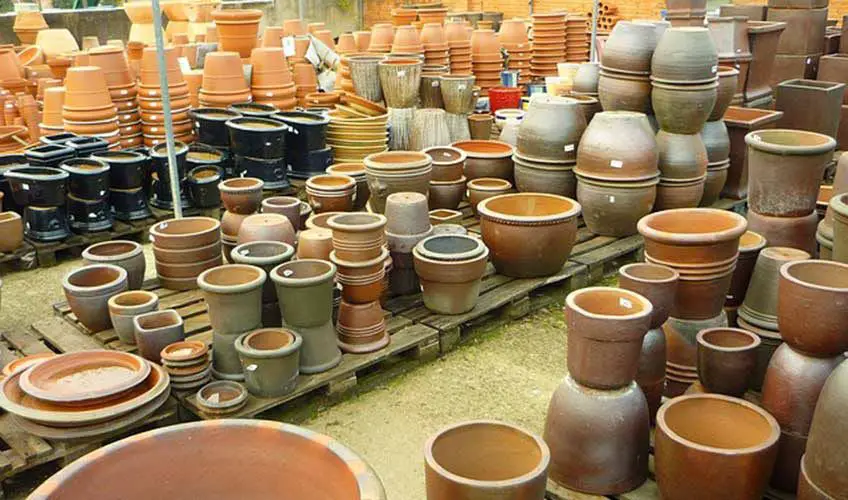Are Clay Pots Breathable?
Breathable materials allow air and moisture to pass through them. Clay pots have been used for centuries as breathable containers for growing plants. The porosity or breathability of clay is an important property that makes clay pots beneficial for healthy plant growth.
Clay is composed of microscopic particles that when fired, maintain tiny spaces between them. This gives clay its porous characteristics. The breathability and air permeability of the clay allows oxygen to reach the roots and excess moisture to evaporate. This helps regulate the moisture and air environment within the pot.
The purpose of breathable pots is to create the ideal soil environment for plants. Breathable containers prevent overwatering and allow for air circulation around the roots. This promotes healthy root growth and prevents issues like root rot due to excess moisture accumulation.
Clay Composition
Clay pots are primarily made from two main ingredients – clay and water 1. The type of clay used can vary, but common types include earthenware, stoneware, and terracotta. Clay is a porous material composed of fine-grained minerals like silica, alumina, and iron oxides 2. When clay is mixed with water it becomes soft and moldable. The clay maintains its shape as it air dries or is fired in a kiln. This porosity gives clay pots the ability to allow air and moisture to permeate through them.
Firing Process
The firing process hardens clay at high temperatures, typically between 1,800-2,400°F. As the clay heats up, the materials vitrify, which fuses them into a non-porous glassy substance.[1] However, most clays are fired below vitrification temperatures, leaving some porosity intact. Firing clay at successively higher temperatures causes the porosity to decrease as pores collapse and solidify.[2] This creates small, micro-pores within the clay that make it permeable to air and moisture.
Water Permeability
Clay pots can allow water to pass through their walls, depending on the porosity of the clay they are made from. If the clay is highly porous, more gaps and tiny holes exist in the material which allows water to permeate through (Eye of the Day Garden Design Center). The porosity of terracotta pots depends on factors like the firing temperature and mineral composition of the clay (Permies.com). Low-fired or underfired clay tends to be very porous, allowing the pot to readily absorb or release water. Firing the clay at higher temperatures makes it less porous and less permeable to water.
Air Permeability
Clay pots are very porous, which allows them to have excellent air permeability. Air can freely pass in and out of the pores of the clay (1). This air permeability provides a key benefit – it allows air exchange with the external environment (2). With air able to freely enter and exit the pot, oxygen is supplied to the plant roots. This is critical for healthy root growth and function. The excellent air permeability of clay pots gives plant roots the oxygen they need to thrive.
(1) https://www.etsy.com/listing/1111148814/four-leaf-clover-lucky-charm-pots-very

(2) https://www.sciencedirect.com/science/article/abs/pii/S0169131709002336
Moisture Control
The breathability of clay pots allows moisture to evaporate through the porous walls and also for water vapor in humid air to condense inside the pots. When a moist soil mix is inside a clay pot, some of the moisture from the soil will evaporate through the pot’s walls at a slow and regulated pace, while excess humidity from the air can also condense on the pot walls and return to the soil over time (1).
This moisture exchange slows evaporation, preventing the soil from drying out excessively while also keeping the soil from becoming overly saturated. Unglazed clay is somewhat permeable to water vapor but not to liquid water. The porosity creates a self-regulating system where the evaporation through the pot walls increases as the soil dries out and decreases as moisture returns. This provides a steady supply of moisture ideal for many plants.
Breathability Benefits
One of the main benefits of breathable clay pots is improved aeration for the plant roots. Clay’s porous nature allows air to permeate the sides of the pot and get to the root system. This increased oxygenation creates a healthier root environment. Standard plastic pots restrict airflow and can lead to suffocation of roots over time. As noted by Living Soils Fertiliser, breathable pots provide “increased oxygen to roots and increased health and growth.”
Breathable clay pots also offer better drainage than nonporous materials. Water can evaporate through the permeable clay walls rather than gettinglogged at the bottom of the pot. Excess moisture can lead to root rot and other problems if drainage is poor. The air pruning that occurs with breathable pots encourages the roots to branch outwards into the soil instead of circling the interior surface area. This outward root growth allows the plant to uptake more nutrients and water.
The porosity and wicking action of clay can also lead to more natural watering cycles. As described by Hypnoseeds, “clay pots absorb moisture from the soil then release it back as the soil dries.” This creates a self-sufficient irrigation system powered by the breathability of the clay material.
Factors Affecting Breathability
There are several key factors that impact the breathability of clay pots:
Clay Thickness – Thicker clay is less porous and permeable to air and moisture. Thinner clay allows more airflow and breathability. Very thin clay may be too fragile, so ideal thickness depends on the type of clay and intended use.
Firing Temperature – Higher firing temperatures create denser clay with lower permeability. Cooler firing makes more porous, breathable clay. However, improperly fired clay is weaker and less durable.
Glazes – Unglazed clay is more breathable. Natural glazes like beeswax increase breathability. Modern glazes with glass-like surfaces seal the clay and reduce permeability.
Clay Type – The natural composition and mineral content of different clays impacts porosity. Some clays are inherently more porous and breathable than others.
Improving Breathability
When it comes to maximizing breathability, terracotta clay tends to be more porous and permeable than other types of clay. This is due to terracotta’s low firing temperature and generally coarser particles compared to clays like stoneware or porcelain. Proper firing is also essential – terracotta fired between 930-1050°C will be the most porous and breathable. Firing at higher temperatures causes the clay particles to vitrify, reducing permeability.
Unglazed terracotta is significantly more breathable than glazed. The glassy surface of ceramic glazes seals the pores of the clay beneath, restricting air flow. An unglazed terracotta vessel provides maximum breathability. Specific clay composition, optimal firing temperature, and avoiding the application of an impermeable glaze are key factors for improving the breathability of terracotta pots.
Conclusion
In summary, clay pots are breathable due to their porous nature which allows air and moisture to pass through. The clay material, firing process at high temperatures, and lack of glaze coatings contribute to the breathability. This breathability provides benefits for plants by promoting airflow to the roots and controlling moisture levels in the soil. While factors like wall thickness, firing temperature, and glazes can affect breathability, unglazed terracotta clay pots offer the highest degree of breathability. Their porous structure makes clay pots like terracotta an excellent choice for a wide variety of plants.

